 |
|
|
|

|

|
Humanity's victory over rust! |
|
|
|
|
|
|
Check the picture on the right, which is engraved on the blade of an old dessert knife.
There's the iconic image of Saint George slaying his dragon, and you may think that the Italian knife
maker Coricama (Coltellerie Riunite Caslino Maniago) chose this image because of the sword in the
saint's hand. The motto on top says otherwise: it proudly declares "Ho vinto la ruggine", which means,
"I've
vanquished rust!" The same message is conveyed less dramatically in the word "Inoxid" at the bottom under the shield: it tells us that the blade in question is made of Inoxidable -- or, in modern parlance, Stainless -- steel. This may seem obvious today, when all cutlery is made of that wonderful alloy of iron, nickel and chromium. It's easy to forget that for most of human history anything made from steel would definitely oxidize -- rust -- if you didn't keep it dry, painted or oiled. Stainless steel was introduced only in the second decade of the 20th century, and Coricama's triumphant logo reflects this innovation. |
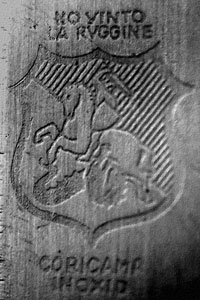
|
|
|
|
I'm sure there are lofty museums out there that trace the history of Steel, but I managed to get a quick tour of the development of cutlery in the 20th century in a more humble setting: I raided the kitchen drawers at my parents' home. These hold a variety of implements and table settings going back at least 3 generations... |
|
|
|
The tour starts with this large kitchen knife, which dates to before the arrival of St. George on the scene: the hallmark (inset) tells us it was made by Ed Wüsthof Dreizackwerk of Solingen, Germany, a city famous for its knife production. It is a fine knife -- still true and sharp after a century of use -- but it is definitely Oxidable... you can see the rusty stains here and there. The company that made it, still using the same trident logo, is still proudly making knives today. |
|
|
|
 A trusty but rusty Pre-stainless knife by Ed Wüsthof |
|
|
|
While rust was a clear issue with pre-stainless cutlery, it had another drawback that has been all but forgotten today: carbon steel would react with and affect the taste of the food it touched. This is the reason for those funky-looking fish knives still seen today on occasion: to avoid tainting the delicate flavor of fish dishes, they were given their separate silver knives. The setting below had belonged to my great-grandparents and is silver plated; the hallmark informs us that the plating is 80% silver. |
|
|
|
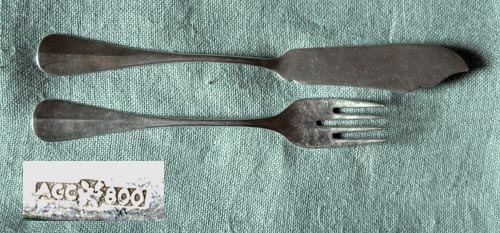 Silver plated fish tableware |
|
|
|
And then, around 1915, Stainless Steel was introduced to the world of cutlery, and everything changed. The earliest example on our tour is the set below, monogrammed with my late grandfather's initials and acquired when he married my grandmother in 1924. In those days products were made to last, and a wedding acquisition was expected to last you a lifetime; this one certainly did, and is still used by the original owners' grandchildren and great-grandchildren on family occasions. The design is old fashioned, with a steel blade stuck in a separate handle, but the quality is very evident... no surprise when you note that the maker is the famous Solingen firm of J.A. Henckels, whose familiar twins logo was in use as early as 1731 and is still in use today. |
|
|
|
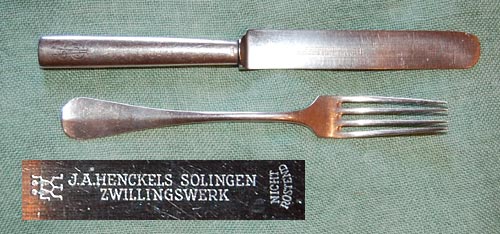 Early stainless tableware by J.A. Henckels |
|
|
|
And here is the lovely dessert knife with the victorious St. George logo mentioned above. Still pre-WW2, but note the more modern shape of the blade. |
|
|
|
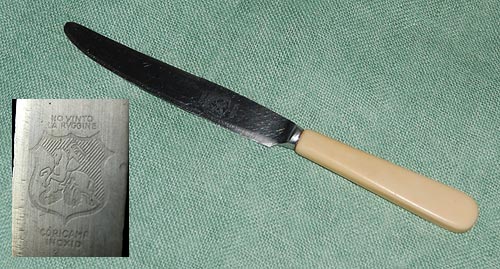 A stainless dessert knife by Coricama |
|
|
|
The sixties saw a revolution in Stainless Steel design, with Scandinavia taking a lead. The next set were made in Denmark, and shows the modern lines, one-piece construction, and "Stainless" hallmark that have since become ubiquitous. |
|
|
|
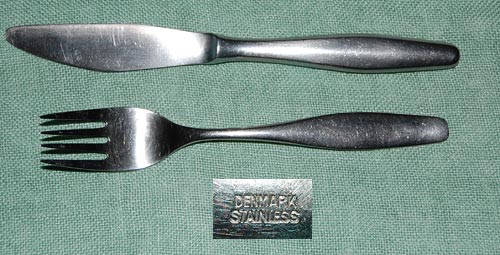 A Danish stainless steel set from the sixties |
|
|
|
The brand names for the wonderful new steel also evolved as the century progressed. The early term "Inoxid", or "Inox" has all but disappeared today, though it does remain visible in the name of the Swiss company Victorinox, maker of the famous Swiss Army Knife and of the knife in the photo below. Note that Henckels had no use for newfangled names like "Inoxid" even back then; the blade we saw is inscribed matter-of-factly "Nicht Rostend", a phrase that has found its way into the trade name "Nirosta", registered by Krupp in 1922. Even today, Henckels's excellent knives are marked "No stain" in preference to "Stainless", the name most commonly used since the sixties. |
|
|
|
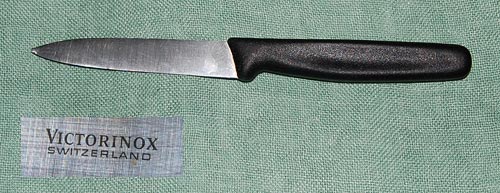 A stainless knife by Victorinox |
|
|
|
Lastly, here is a cheese knife claiming "super stainless" construction, from
Sheffield, Britain's answer to Solingen. The vendor,
Viners, made sure to point out he was a provider of cutlery by appointment to His
Majesty the King (George VI, I presume). He was also providing some, though without any such appointment, to my grandparents! |
|
|
|
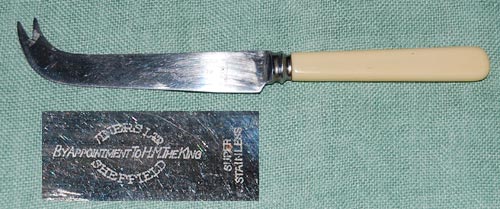 A stainless cheese knife from Sheffield |
|
|
|
|
|
|
|
Home | HOC | Fractals | Miscellany | About | Contact Copyright © 2009 N. Zeldes. All rights reserved. |
|